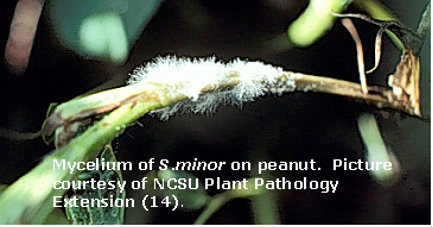White Mold a.k.a. Sclerotinia Stem Rot
go.ncsu.edu/readext?829845
en Español / em Português
El inglés es el idioma de control de esta página. En la medida en que haya algún conflicto entre la traducción al inglés y la traducción, el inglés prevalece.
Al hacer clic en el enlace de traducción se activa un servicio de traducción gratuito para convertir la página al español. Al igual que con cualquier traducción por Internet, la conversión no es sensible al contexto y puede que no traduzca el texto en su significado original. NC State Extension no garantiza la exactitud del texto traducido. Por favor, tenga en cuenta que algunas aplicaciones y/o servicios pueden no funcionar como se espera cuando se traducen.
Português
Inglês é o idioma de controle desta página. Na medida que haja algum conflito entre o texto original em Inglês e a tradução, o Inglês prevalece.
Ao clicar no link de tradução, um serviço gratuito de tradução será ativado para converter a página para o Português. Como em qualquer tradução pela internet, a conversão não é sensivel ao contexto e pode não ocorrer a tradução para o significado orginal. O serviço de Extensão da Carolina do Norte (NC State Extension) não garante a exatidão do texto traduzido. Por favor, observe que algumas funções ou serviços podem não funcionar como esperado após a tradução.
English
English is the controlling language of this page. To the extent there is any conflict between the English text and the translation, English controls.
Clicking on the translation link activates a free translation service to convert the page to Spanish. As with any Internet translation, the conversion is not context-sensitive and may not translate the text to its original meaning. NC State Extension does not guarantee the accuracy of the translated text. Please note that some applications and/or services may not function as expected when translated.
Collapse ▲White mold, also known as sclerotinia stem rot is a serious and typically lethal fungal disease that affects over 400 species of plants in many plant families. There are a number of species of this fungus. While we can see this problem in our vegetable gardens, we also see it on many annual and perennial ornamental plants as well. What we actually see depends on the plant that is playing the unfortunate host to this fungal disease.
This fungus can appear as crown rot or localized infected areas called stem cankers. It can be seen as root rot, damping off of seedlings, blossom rot, or fruit rot. The  host plant wilts because the stems can be girdled at or near the stem line. The mycelia of the fungus- those cotton-looking threads appear. A telltale feature is hard, irregularly shaped masses that look like little tan, to brown BBs develop within or on the surface of the plant that turn darker brown or black as they mature, resembling mouse or rat droppings.
host plant wilts because the stems can be girdled at or near the stem line. The mycelia of the fungus- those cotton-looking threads appear. A telltale feature is hard, irregularly shaped masses that look like little tan, to brown BBs develop within or on the surface of the plant that turn darker brown or black as they mature, resembling mouse or rat droppings.
It’s the case for cleaning up. Sanitation is important. White mold fungal bodies will overwinter in dead plant material or infested soil and it can survive for at least 5 years. During periods of cool, wet, or humid weather the sclerotia germinate – to form the fungal threads or the tiny mushroom-like spore-producing bodies able to release millions of spores over a matter of days. Some are spread by wind, others by rain or even insects that will start new infections on dead or dying (think spent flowers and shed leaves) plant parts.
Scout about in your garden as the weather turns cooler and wetter. If you’ve got it, you’ve got some pruning to do. Prune 4-5 inches below where the disease infection is operating or remove the entire plant if it is consumed by this fungal disease. Then get these pruned materials off your property, do not compost them as they are long lived and the fungal bodies can spread the disease. Be sure to disinfect and sanitize your cutting tools so you don’t spread the spores from plant to plant.
There are some ways to avoid this fungal infection in the future. Make sure your soils drain well and that you are not over watering. Drip or soaker hose irrigation applying water to the soil early in the morning instead of overhead irrigation that wets the foliage is preferable. Promote good air circulation in your garden with proper plant placement instead of crowding plants together so they can dry faster when they get wet. Keep the weeds under control and don’t over fertilize with nitrogen to keep the foliage from growing at an accelerated rate.
If you do find that you have a severe infestation, remember that Sclerotia can persist for years in the soil, so you may want to change out the soil in your planting beds. There are fungicides that can be used at various times in the plants lifecycle as a preventative measure. See the Southeastern US Pest Control Guide for Nursery Crops and Landscape Plantings for more information or contact your county Extension agent for more specific information.
Minda Daughtry is the Horticulture Agent for North Carolina Cooperative Extension in Lee County.




